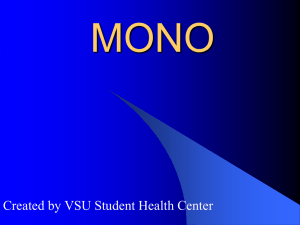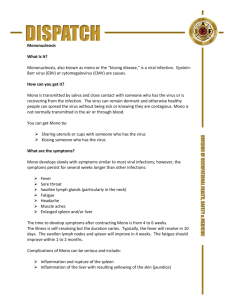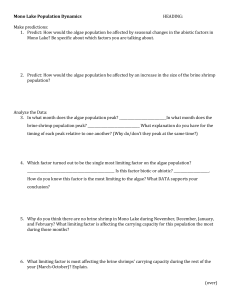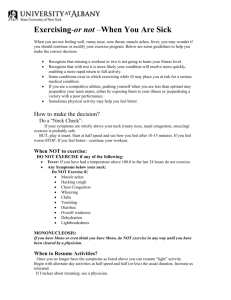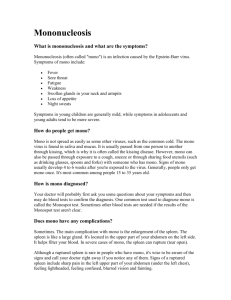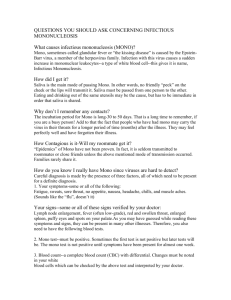printed description - USC Signal and Image Processing Institute
advertisement
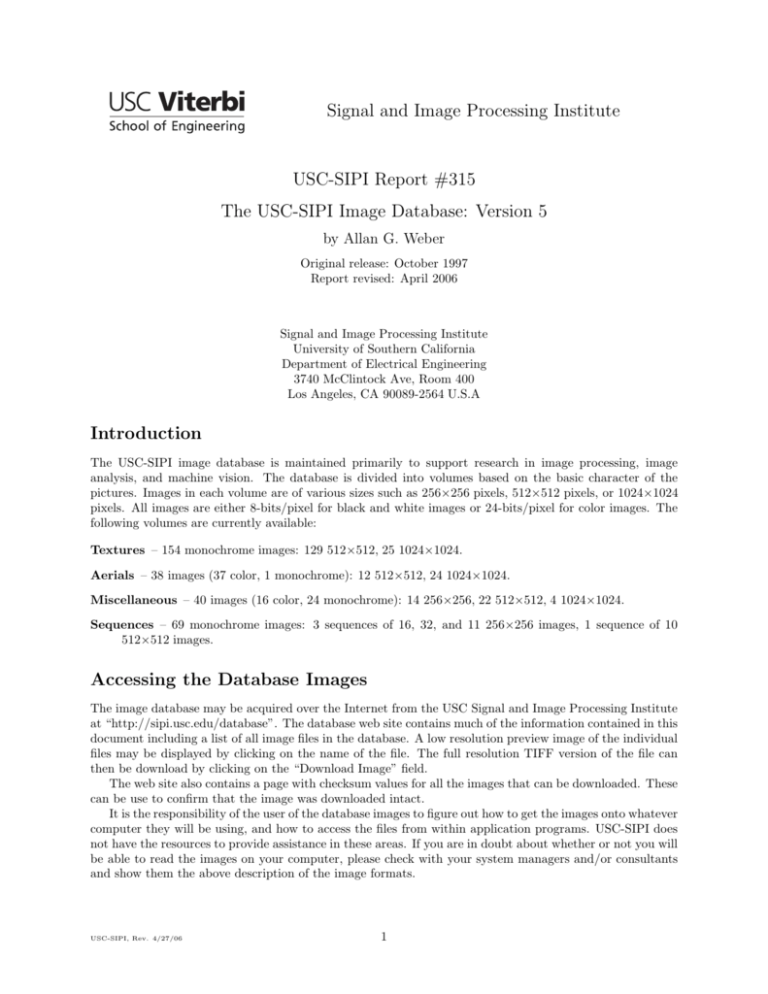
Signal and Image Processing Institute USC-SIPI Report #315 The USC-SIPI Image Database: Version 5 by Allan G. Weber Original release: October 1997 Report revised: April 2006 Signal and Image Processing Institute University of Southern California Department of Electrical Engineering 3740 McClintock Ave, Room 400 Los Angeles, CA 90089-2564 U.S.A Introduction The USC-SIPI image database is maintained primarily to support research in image processing, image analysis, and machine vision. The database is divided into volumes based on the basic character of the pictures. Images in each volume are of various sizes such as 256×256 pixels, 512×512 pixels, or 1024×1024 pixels. All images are either 8-bits/pixel for black and white images or 24-bits/pixel for color images. The following volumes are currently available: Textures – 154 monochrome images: 129 512×512, 25 1024×1024. Aerials – 38 images (37 color, 1 monochrome): 12 512×512, 24 1024×1024. Miscellaneous – 40 images (16 color, 24 monochrome): 14 256×256, 22 512×512, 4 1024×1024. Sequences – 69 monochrome images: 3 sequences of 16, 32, and 11 256×256 images, 1 sequence of 10 512×512 images. Accessing the Database Images The image database may be acquired over the Internet from the USC Signal and Image Processing Institute at “http://sipi.usc.edu/database”. The database web site contains much of the information contained in this document including a list of all image files in the database. A low resolution preview image of the individual files may be displayed by clicking on the name of the file. The full resolution TIFF version of the file can then be download by clicking on the “Download Image” field. The web site also contains a page with checksum values for all the images that can be downloaded. These can be use to confirm that the image was downloaded intact. It is the responsibility of the user of the database images to figure out how to get the images onto whatever computer they will be using, and how to access the files from within application programs. USC-SIPI does not have the resources to provide assistance in these areas. If you are in doubt about whether or not you will be able to read the images on your computer, please check with your system managers and/or consultants and show them the above description of the image formats. USC-SIPI, Rev. 4/27/06 1 Data Format Image files in the SIPI Image Database are currently stored in TIFF format. Previous versions of the SIPI database stored files in raw binary format with no image information attached to the file. The TIFF format has two advantages over the raw format. Information about the image size (width, length, depth) are stored in the file and can be extracted by TIFF reader software. In addition, it allows color images to be stored as a single file rather than as three files. Some information about the TIFF format is available from “http://www.awaresystems.be/imaging/tiff.html” and from Adobe Systems. The “libtiff” library of C functions for reading and writing TIFF images is available from “http://www.remotesensing.org/libtiff/”. The “netpbm” collection of image format conversion programs (http://netpbm.sourceforge.net/) can convert between TIFF and many different formats. A sample C program for converting an image from TIFF to raw format on a Unix system is available on the SIPI web site. This program should convert the color (24 bits/pixel) and grayscale (8 bits/pixel) images in the database into the raw binary format files. This program requires the ”libtiff” library available at the site mentioned above. Note that while we believe this program works properly on the TIFF images in the database, it has not been tested on other TIFF images and may not convert them correctly. Origin of the Images Most of the images in the database were scanned over a period of several years, usually by graduate students at USC-SIPI. Some of the older images in the Miscellaneous and Sequences volumes were scanned with a Muirhead flatbed scanner. The Textures and Aerials volumes, and the newer images in the Miscellaneous and Sequences volumes were scanned with a Optronics C-4100HS drum scanner. For the most part, there is very little additional technical information available about the images, such as scanning resolution, etc. If you have questions about the scanning process or need other information about the images, please contact us at telephone number (213) 740-4145 or send email to “database@sipi.usc.edu”. The Brodatz texture images are not scans of the pages in the texture book but were instead scanned from black and white photographic prints of textures that were purchased from the author of the book. The prints that were received from the author were not identical in all cases to those shown in the book. These texture images are labeled with the page number of the corresponding texture in the book. While the scanned images are of the same texture material, they are not an image of a portion of the page shown in the book. Some of the images in the database were scanned from copyrighted material. The image data was generated from this material with the sole intention of using it for research in image processing and related areas. None of these images should be used for commercial purposes unless you have determined that doing so would not violate any copyright. While SIPI does have information on some of the images, the origin of many is unknown. If you have questions about the origins of a particular image or its copyright status, you can contact us. Be advised, that in most cases our answer to your questions will be that we have no useful information. Users of the database images should be aware that a few of the images have a few blank or otherwise incorrect lines at the top or bottom or sides of the images due to the scanning process. These generally do not extend more that one or two pixels into the image area. In addition, in some of the images the outer portions of the scanned area contains elements from the borders of the film such as 35mm sprocket holes, alignment marks, etc. Database on CD-R Media For those who can not or do not wish to access the database images via the Internet, USC-SIPI can supply the database images on CD-R. CD-R’s are written in a format that “should” be readable on any PC, Mac, or Unix system with a CD-ROM drive. Cost is $40 for the complete database. It is the database purchaser’s responsibility to figure out how to read the images into whatever computer they will be using, and how to access the files from within application programs. USC-SIPI does not have the USC-SIPI, Rev. 4/27/06 2 resources to provide assistance in these areas. If you are in doubt about whether or not you will be able to read the images on your computer, please check with your system managers and show them the description of the image formats. For U.S. Customers • Purchase orders or checks accepted in advance. • No credit cards are accepted. • California orders must add sales tax. For Foreign Customers • Orders must be paid in advance (including shipping costs) by cashier’s check or money order drawn in U.S. dollars on a U.S. bank. • No letters of credit accepted. Checks should be payable to the Signal and Image Processing Institute. Shipping costs will be added to the price. Contact USC-SIPI for a quote on the shipping costs. Please send orders to Laboratory Accountant University of Southern California Signal and Image Processing Institute 3740 McClintock Ave., Suite 404 Los Angeles, CA 90089-2564 For more information, please write to the above address, or call 213-740-4145, or send email to “services @ sipi.usc.edu”. Table of Contents The following pages list the contents of all volumes in the database. Each image in the table of contents is listed along with the following information: File name: This is the name of the image file, without the trailing extension of “.tiff”. Many of the images have numerical file names due to an identification scheme used in an earlier version of the database. Image description: A brief description of the image contents. Image size: This is the image size in pixels. All images are square unless indicated otherwise. Color/Mono: Indicates whether the image is a 24-bit color image or an 8-bit monochrome image. Following the table of contents are reproductions of most of the images in the database. USC-SIPI, Rev. 4/27/06 3 Volume 1. – TEXTURES For the Brodatz texture images, the number in parenthesis (i.e. D12) is the page number in the Brodatz texture book that the image came from (P. Brodatz, Textures: A Photographic Album for Artists and Designers, Dover Publications, New York, 1966). Images 1.2.01 through 1.2.13 (marked below with a ‘∗’) are histogram equalized versions of 1.1.01 through 1.1.13. Name 1.1.01 1.1.02 1.1.03 1.1.04 1.1.05 1.1.06 1.1.07 1.1.08 1.1.09 1.1.10 1.1.11 1.1.12 1.1.13 1.2.01 1.2.02 1.2.03 1.2.04 1.2.05 1.2.06 1.2.07 1.2.08 1.2.09 1.2.10 1.2.11 1.2.12 1.2.13 1.3.01 1.3.02 1.3.03 1.3.04 1.3.05 1.3.06 1.3.07 1.3.08 1.3.09 1.3.10 1.3.11 1.3.12 1.3.13 USC-SIPI, Rev. 4/27/06 Description Brodatz - Grass (D9) Brodatz - Bark (D12) Brodatz - Straw (D15) Brodatz - Herringbone weave (D15) Brodatz - Woolen cloth (D19) Brodatz - Pressed calf leather (D24) Brodatz - Beach sand (D29) Brodatz - Water (D38) Brodatz - Wood grain (D68) Brodatz - Raffia (D84) Brodatz - Pigskin (D92) Brodatz - Brick wall (D94) Brodatz - Plastic bubbles (D112) Brodatz - Grass (D9) * Brodatz - Bark (D12) * Brodatz - Straw (D15) * Brodatz - Herringbone weave (D16) * Brodatz - Woolen cloth (D19) * Brodatz - Pressed calf leather (D24) * Brodatz - Beach sand (D29) * Brodatz - Water (D38) * Brodatz - Wood grain (D68) * Brodatz - Raffia (D84) * Brodatz - Pigskin (D92) * Brodatz - Brick wall (D94) * Brodatz - Plastic bubbles (D112) * Brodatz - Grass (D9) Brodatz - Bark (D12) Brodatz - Straw (D15) Brodatz - Woolen cloth (D19) Brodatz - Herringbone weave (D16) Brodatz - Pressed calf leather (D24) Brodatz - Beach sand (D29) Brodatz - Water (D38) Brodatz - Wood grain (D68) Brodatz - Raffia (D84) Brodatz - Pigskin (D92) Brodatz - Brick wall (D94) Brodatz - Plastic bubbles (D112) 4 Size 512 512 512 512 512 512 512 512 512 512 512 512 512 512 512 512 512 512 512 512 512 512 512 512 512 512 1024 1024 1024 1024 1024 1024 1024 1024 1024 1024 1024 1024 1024 Color/Mono Mono Mono Mono Mono Mono Mono Mono Mono Mono Mono Mono Mono Mono Mono Mono Mono Mono Mono Mono Mono Mono Mono Mono Mono Mono Mono Mono Mono Mono Mono Mono Mono Mono Mono Mono Mono Mono Mono Mono Name 1.4.01 1.4.02 1.4.03 1.4.04 1.4.05 1.4.06 1.4.07 1.4.08 1.4.09 1.4.10 1.4.11 1.4.12 1.5.01 1.5.02 1.5.03 1.5.04 1.5.05 1.5.06 1.5.07 Description Brick wall Wood shingle roof Wood shingle roof Brick wall Tile roof Wood fence Metal grates Brick wall Brick wall Grass Sand Sand Brick wall Hexagonal hole array Rough wall Sand Gravel Brick wall Grass Size 1024 1024 1024 1024 1024 1024 1024 1024 1024 1024 1024 1024 512 512 512 512 512 512 512 Color/Mono Mono Mono Mono Mono Mono Mono Mono Mono Mono Mono Mono Mono Mono Mono Mono Mono Mono Mono Mono The texture mosaics (texmos1, texmos2, and texmos3) are mosaics of eight Brodatz textures for use in image texture segmentation research. The files texmos2.s512 and texmos3.s512 are images containing eight gray levels which indicate which of the eight textures are present at each point in the corresponding texture mosaic. A document containing a more detailed description of the texture mosaics is available on the SIPI web site. Name texmos1.p512 texmos2.p512 texmos2.s512 texmos3.p512 texmos3b.p512 texmos3.s512 Description USC texture USC texture USC texture USC texture USC texture USC texture mosaic mosaic mosaic mosaic mosaic mosaic #1 #2 #2 (info) #3 #3 (modified) #3 (info) Size 512 512 512 512 512 512 Color/Mono Mono Mono Mono Mono Mono Mono The following images are a set of Brodatz textures digitized at seven different rotation angles: 0, 30, 60, 90, 120, 150, and 200 degrees. The images were digitized using a 512×512 pixel video digitizer. In general , the quality of the scans is not as good as those of the Brodatz images above. There are a total of 91 images in the rotation set (13 textures at 7 rotations.) The filenames indicate the texture subject and the angle of rotation (e.g. bark.000, bark.030, bark.060, etc.) USC-SIPI, Rev. 4/27/06 5 Name bark brick bubbles grass leather pigskin raffia sand straw water weave wood wool USC-SIPI, Rev. 4/27/06 Description Bark (D12) Brick (D94) Bubbles (D112) Grass (D9) Leather (D24) Pigskin (D92) Raffia (D84) Sand (D29) Straw (D15) Water (D38) Weave (D16) Wood (D68) Wool (D19) Size 512 512 512 512 512 512 512 512 512 512 512 512 512 6 Color/Mono Mono Mono Mono Mono Mono Mono Mono Mono Mono Mono Mono Mono Mono Volume 2. – AERIALS Name 2.1.01 2.1.02 2.1.03 2.1.04 2.1.05 2.1.06 2.1.07 2.1.08 2.1.09 2.1.10 2.1.11 2.1.12 2.2.01 2.2.02 2.2.03 2.2.04 2.2.05 2.2.06 2.2.07 2.2.08 2.2.09 2.2.10 2.2.11 2.2.12 2.2.13 2.2.14 2.2.15 2.2.16 2.2.17 2.2.18 2.2.19 2.2.20 2.2.21 2.2.22 2.2.23 2.2.24 3.2.25 wash-ir USC-SIPI, Rev. 4/27/06 Description San Diego, CA (Miramar NAS) San Diego, CA San Francisco, CA (Golden Gate) Oakland, CA San Diego, CA (North Island NAS) Woodland Hills, CA Foster City, CA San Diego, CA San Diego, CA (Point Loma) San Diego, CA (Shelter Island) Earth from space San Diego, CA (Downtown) San Diego, CA San Diego, CA San Diego, CA Richmond, CA San Diego, CA (Miramar NAS) San Francisco, CA (Bay Bridge) Oakland, CA San Diego, CA San Francisco, CA Richmond and San Rafael, CA Stockton, CA San Francisco and Oakland, CA Stockton, CA Shreveport, LA San Francisco, CA San Francisco, CA San Francisco, CA Stockton, CA Stockton, CA Stockton, CA San Francisco, CA San Francisco and Oakland, CA San Diego, CA Stockton, CA Pentagon building Washington, D.C. (infra-red) 7 Size 512 512 512 512 512 512 512 512 512 512 512 512 1024 1024 1024 1024 1024 1024 1024 1024 1024 1024 1024 1024 1024 1024 1024 1024 1024 1024 1024 1024 1024 1024 1024 1024 1024 2250 Color/Mono Color Color Color Color Color Color Color Color Color Color Color Color Color Color Color Color Color Color Color Color Color Color Color Color Color Color Color Color Color Color Color Color Color Color Color Color Mono Color Volume 3. – MISCELLANEOUS Name 4.1.01 4.1.02 4.1.03 4.1.04 4.1.05 4.1.06 4.1.07 4.1.08 4.2.01 4.2.02 4.2.03 4.2.04 4.2.05 4.2.06 4.2.07 5.1.09 5.1.10 5.1.11 5.1.12 5.1.13 5.1.14 5.2.08 5.2.09 5.2.10 5.3.01 5.3.02 7.1.01 7.1.02 7.1.03 7.1.04 7.1.05 7.1.06 7.1.07 7.1.08 7.1.09 7.1.10 7.2.01 boat.512 elaine.512 house gray21.512 numbers.512 ruler.512 testpat.1k USC-SIPI, Rev. 4/27/06 Description Girl Couple Girl Girl House Tree Jelly beans Jelly beans Splash Girl (Tiffany) Mandrill (a.k.a. Baboon) Girl (Lena, or Lenna) Airplane (F-16) Sailboat on lake Peppers Moon surface Aerial Airplane Clock Resolution chart Chemical plant Couple Aerial Stream and bridge (only 64 gray levels) Man Airport Truck Airplane Tank Car and APCs Truck and APCs Truck and APCs Tank APC Tank Car and APCs Airplane (U-2) Fishing Boat Girl (Elaine) House 21 level step wedge 256 level test pattern Pixel ruler General test pattern 8 Size 256 256 256 256 256 256 256 256 512 512 512 512 512 512 512 256 256 256 256 256 256 512 512 512 1024 1024 512 512 512 512 512 512 512 512 512 512 1024 512 512 512 512 512 512 1024 Color/Mono Color Color Color Color Color Color Color Color Color Color Color Color Color Color Color Mono Mono Mono Mono Mono Mono Mono Mono Mono Mono Mono Mono Mono Mono Mono Mono Mono Mono Mono Mono Mono Mono Mono Mono Color Mono Mono Mono Mono Volume 4. – SEQUENCES Each of the sequences consist of multiple images showing motion of the subject matter. The image filenames consist of the name shown below followed by the number in the sequence (e.g. 6.1.01, 6.1.02, etc.) Sequence 6.2 consists of 32 images but only the first 16 appear to be a true motion sequence. Images 17 through 32 show some motion but not in any clear direction. They are included in the database only because they have been part of it for several years. Name 6.1 6.2 6.3 motion USC-SIPI, Rev. 4/27/06 Description Walter Cronkite moving head Chemical plant flyover (close view) Chemical plant flyover (far view) Toy vehicles 9 Size 256 256 256 512 Frames 16 32 11 10 Color/Mono Mono Mono Mono Mono Volume 1: Textures - Brodatz textures, 512×512 1.1.01 1.1.02 1.1.03 1.1.04 1.1.05 1.1.06 1.1.07 1.1.08 1.1.09 1.1.10 1.1.11 1.1.12 USC-SIPI, Rev. 4/27/06 10 1.1.13 Volume 1: Textures - Brodatz textures, 512×512, histogram equalized 1.2.01 1.2.02 1.2.03 1.2.04 1.2.05 1.2.06 1.2.07 1.2.08 1.2.09 USC-SIPI, Rev. 4/27/06 11 1.2.10 1.2.11 1.2.12 1.2.13 Volume 1: Textures - Brodatz textures, 1024×1024 1.3.01 1.3.02 1.3.03 1.3.04 1.3.05 1.3.06 USC-SIPI, Rev. 4/27/06 12 1.3.07 1.3.08 1.3.09 1.3.10 1.3.11 1.3.12 1.3.13 Volume 1: Textures - Miscellaneous textures, 1024×1024 1.4.01 USC-SIPI, Rev. 4/27/06 1.4.02 13 1.4.03 1.4.04 1.4.05 1.4.06 1.4.07 1.4.08 1.4.09 1.4.10 1.4.11 Volume 1: Textures - Miscellaneous textures, 512×512 1.4.12 1.5.01 USC-SIPI, Rev. 4/27/06 1.5.02 14 1.5.03 1.5.04 1.5.05 1.5.06 texmos1.p512 texmos2.p512 texmos2.s512 texmos3.p512 texmos3b.p512 texmos3.s512 1.5.07 Volume 1: Textures - Texture mosaics, 512×512 USC-SIPI, Rev. 4/27/06 15 Volume 2: Aerials - 512×512 2.1.01 2.1.02 2.1.03 2.1.04 2.1.05 2.1.06 2.1.07 2.1.08 2.1.09 2.1.10 2.1.11 2.1.12 USC-SIPI, Rev. 4/27/06 16 Volume 2: Aerials - 1024×1024 2.2.01 2.2.02 2.2.03 2.2.04 2.2.05 2.2.06 2.2.07 2.2.08 2.2.09 2.2.10 2.2.11 2.2.12 USC-SIPI, Rev. 4/27/06 17 2.2.13 2.2.14 2.2.15 2.2.16 2.2.17 2.2.18 2.2.19 2.2.20 2.2.21 2.2.22 2.2.23 2.2.24 USC-SIPI, Rev. 4/27/06 18 3.2.25 Volume 2: Aerials - Other sizes wash-ir USC-SIPI, Rev. 4/27/06 19 Volume 3: Miscellaneous - 256×256 4.1.01 4.1.02 4.1.03 4.1.04 4.1.05 4.1.06 4.1.07 4.1.08 5.1.09 5.1.10 USC-SIPI, Rev. 4/27/06 20 5.1.11 5.1.12 Volume 3: Miscellaneous - 512×512 5.1.13 5.1.14 4.2.01 4.2.02 4.2.03 4.2.04 4.2.05 4.2.06 4.2.07 house USC-SIPI, Rev. 4/27/06 21 5.2.08 5.2.09 5.2.10 7.1.01 7.1.02 7.1.03 7.1.04 7.1.05 7.1.06 7.1.07 7.1.08 7.1.09 USC-SIPI, Rev. 4/27/06 22 7.1.10 gray21.512 Volume 3: Miscellaneous - 1024×1024 5.3.01 boat.512 elaine.512 numbers.512 ruler.512 5.3.02 7.2.01 testpat.1k USC-SIPI, Rev. 4/27/06 23 Volume 4: Sequences 6.1.01 6.1.08 6.1.16 6.2.01 6.2.08 6.2.16 6.3.01 6.3.06 6.3.11 motion01.512 motion05.512 motion10.512 USC-SIPI, Rev. 4/27/06 24
